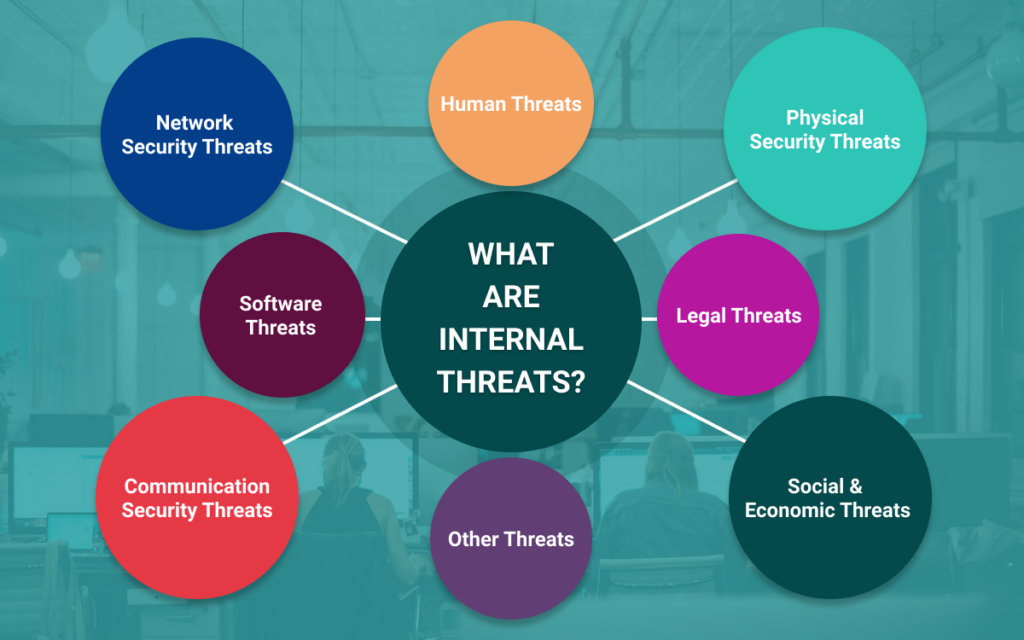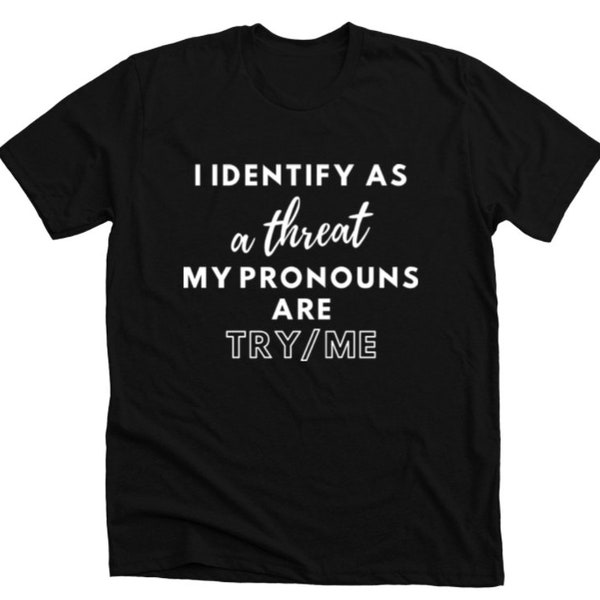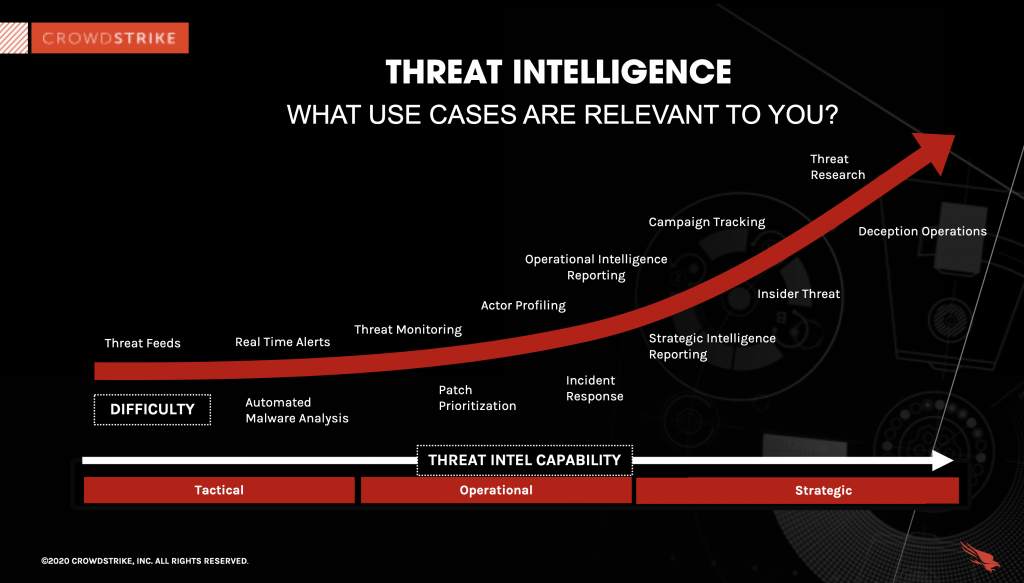
Explain Different Types of Attacks in Network Security XiomarahasChen
What is threat modeling? Threat modeling is a proactive strategy for evaluating cybersecurity threats. It involves identifying potential threats, and developing tests or procedures to detect and respond to those threats. This involves understanding how threats may impact systems, classifying threats and applying the appropriate countermeasures.

I identify as a threat my pronouns are try me funny Tshirt
Much like software bugs, the earlier you identify threats, the more cost effective it is to address them. A threat model is a living document and should continue to evolve as your workloads change. Revisit your threat models over time, including when there is a major change, a change in the threat landscape, or when you adopt a new feature or.

Common Cyber Threats malwareicon in 2020 Cyber security technology
Identify Risk Assessment Identify threats to organizational assets (both internal and external) adversary Identify providers of threat information NIST SP 800-53 Rev. 4 PM-16 ISO/IEC 27001 A.13.1.2 Allows the organization to identify current known IP addresses for servers and block inbound and outbound connections to this source.

I Identify As A Threat Pronouns Are Try Me Shirt
Protect your people from email and cloud threats with an intelligent and holistic approach. Change User Behavior. Help your employees identify, resist and report attacks before the damage is done. Combat Data Loss and Insider Risk. Prevent data loss via negligent, compromised and malicious insiders by correlating content, behavior and threats.

Internal Vs External Threats Here’s All You Need to Know Secure Triad
The report considers the four major types of attacks: evasion, poisoning, privacy and abuse attacks. It also classifies them according to multiple criteria such as the attacker's goals and objectives, capabilities, and knowledge. Evasion attacks, which occur after an AI system is deployed, attempt to alter an input to change how the system.
How To Identify Unseen Threats
Identity threat detection and response (ITDR) is a security procedure for identifying, reducing, and responding to potential identity-based threats, such as compromised user accounts, leaked passwords, data breaches, and fraudulent activity.These identity-based attacks pose serious threats to organizational security. In this article, we'll shed some light on ITDR, the security challenges it.

i identify as a threat my pronouns are try me shirt
Intentional Threats are malicious actions performed by malicious insiders who use technical means to disrupt or halt an organization's regular business operations, identify IT weaknesses, gain protected information, or otherwise further an attack plan via access to IT systems. This action can involve changing data or inserting malware or.

I Identify as A Threat My Pronouns Are Try Me Patch Etsy Australia
Any cyber-attack, no matter how small, is a threat to our national security and must be identified, managed, and shut down. CISA's Role. CISA diligently tracks and shares information about the latest cybersecurity risks, attacks, and vulnerabilities, providing our nation with the tools and resources needed to defend against these threats.

"Pronoun Humor I identify as a threat my pronouns are try/me
Itemizing your application's important characteristics and actors helps you to identify relevant threats during step 4. Step 3: Decompose your application. A detailed understanding of the mechanics of your application makes it easier for you to uncover more relevant and more detailed threats. Step 4: Identify threats.

I identify as a threat
For several weeks, threat actors have been targeting insecure Microsoft SQL database servers (MSSQL) of organizations based in the U.S., EU and Latin America, in order to deploy ransomware. In the ongoing campaign, observed by researchers with Securonix, attackers first brute force administrative passwords on MSSQL servers in order to download.

I Identify As A Threat Pronouns Are Try Me Shirt
To identify threats, you can use SWOT analysis, PESTLE analysis, scenario planning, risk assessment, and feedback. SWOT analysis evaluates strengths and weaknesses while PESTLE analysis examines.

I Identify as a Threat Svg Etsy Australia
A1: Threats are identified as part of the national security planning process and reflected in guidance documents drafted at the outset of a new administration, including the National Security Strategy (NSS) and National Defense Strategy (NDS).

What is Cyber Threat Intelligence? [Beginner's Guide] (2023)
This security threat risk assessment includes not only identifying potential threats, but also assessing the likelihood of occurrence for each. Just because something can happen, doesn't mean it will. The vulnerability assessment. Following the security risk threat assessment is the vulnerability assessment, which has two parts.First, it involves a determination of the assets at risk (e.g.

Official I Identify As A Threat My Pronouns Are Try Me Shirt, hoodie
Threat detection and identification is the process by which persons who might present an insider threat risk due to their observable, concerning behaviors come to the attention of an organization or insider threat team. Detecting and identifying potential insider threats requires both human and technological elements.

I identify as a threat. My pronouns are try /me iFunny
1. Insider threats An insider threat occurs when individuals close to an organization who have authorized access to its network intentionally or unintentionally misuse that access to negatively affect the organization's critical data or systems. This article is part of What is incident response? Plans, teams and tools Which also includes:

I identify as a threat T shirt in 2022 Funny shirt sayings, Sarcastic
The goal of the threat categorization is to help identify threats both from the attacker and the defensive perspective . DFDs produced in step 1 help to identify the potential threat targets from the attacker's perspective, such as data sources, processes, data flows, and interactions with users. These threats can be classified further as the.